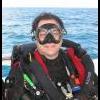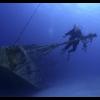If they are high pressure tanks, they will have 300 bar DIN valves on them (compared to the 200 bar DIN valves). These will not have the "dimple" on the rear, capable of accepting a yoke. Also, the inserts will not work to convert them to yoke.If the tanks come with DIN fitting on them, simply buy the thread-in adapter insert for the DIN to yoke conversion on the DIN fitting. They are relatively cheap.
Or order your tanks with a yoke fitting?
Hope this helps.

Steel Tanks
#16

Posted 19 May 2005 - 02:32 PM
"For the diligent diver, closed circuit rebreathers are actually safer than open circuit scuba." Tom Mount
#17

Posted 19 May 2005 - 02:52 PM
Another thread topic, who uses HP vs. LP steel tanks.
#18

Posted 19 May 2005 - 03:02 PM
Great ideaAnother thread topic, who uses HP vs. LP steel tanks.
"For the diligent diver, closed circuit rebreathers are actually safer than open circuit scuba." Tom Mount
#19

Posted 19 May 2005 - 06:26 PM
Well, not for long! LOLOLOLAlso, the inserts will not work to convert them to yoke.
#20

Posted 19 May 2005 - 06:59 PM
So is a galvinized steel tank mean that it is PST? The service pressure on the tanks I'm looking at is 3442. It says galvinized Steel w/ din value.
#21

Posted 19 May 2005 - 07:07 PM
PST is a company that manufacture's tanks. It stands for Pressed Steel Tanks and is a very reputable manufacturer of tanks...when you can get them. The 3442 psig sounds like the PST E7, 120 cu.ft. I have 4 of them and LOVE them. There was a big shortage of them last year. I had to wait 6 months to get my last two.WOW, ask and ye shall receive. Most of you figured out what I was asking. I want to use the steel tanks in FL and be able to use my reg out of country.
So is a galvinized steel tank mean that it is PST? The service pressure on the tanks I'm looking at is 3442. It says galvinized Steel w/ din value.
Edited by RichardB, 19 May 2005 - 07:12 PM.
#22

Posted 19 May 2005 - 07:18 PM
#23

Posted 19 May 2005 - 08:11 PM
WOW, ask and ye shall receive. Most of you figured out what I was asking. I want to use the steel tanks in FL and be able to use my reg out of country.
So is a galvinized steel tank mean that it is PST? The service pressure on the tanks I'm looking at is 3442. It says galvinized Steel w/ din value.
PST is a manufacturer of High Pressure Steel tanks. The tanks are galvanized. The 3442 pressure rating is about as high as you will find in a scuba tank, making PST quite popular. At pressures over 3000 you will definitely want a DIN valve. There are other manufacturers of steel tanks especially if you are interested in lower pressure tanks. They may or may not galvanize the tanks, depending on the manufacturer. The galvanizing is only on the outside, as zinc is not good for you. :-)
You can learn more about PST here:
http://www.pressedsteel.com/
You will also find useful information here:
http://www.diveriteexpress.com/
Because of the machinery required, there are only a few manufacturers of tanks, so many of the same tanks are sold under a variety of brand names. If you see something with identical specifications to a PST tank under another brand name, it is probably a PST tank.
The 80s are very short. They can be doubled, but there are a few challenges. If you want to know about that just ask. For some reason the 80s seem to be very favorably priced vs. both larger and smaller tanks.
Edited by Geek, 19 May 2005 - 08:14 PM.
#25

Posted 19 May 2005 - 11:41 PM
I, for one, would not be overly enthused about converting before each trip or dealing with it while traveling. Yes, there is another failure point and the DIN adapter does make the regulator ever so slightly more prone to head bonking. However, more places carry DIN even when you travel these days. So, you might not even need to use the adapter if the shop/boat carries DIN. I'll bet you can work most of this out in advance of your trip.
Chances are, you will be diving an aluminum 80 at relatively shallow depths on these trips. So, if your regulator does start to leak due to the extra o-ring, which is still pretty darn unlikely, you can deal with it, changing the o-ring after the dive. It's not really that big of a deal. Even a pretty catastrophic failure will usually give you a couple of minutes of gas. Besides, you will have a buddy with you, won't you?
"For the diligent diver, closed circuit rebreathers are actually safer than open circuit scuba." Tom Mount
#26

Posted 19 May 2005 - 11:44 PM
"For the diligent diver, closed circuit rebreathers are actually safer than open circuit scuba." Tom Mount
#27

Posted 20 May 2005 - 06:44 AM
If you are using tanks that fill to 3442, you will have no choice in the matter. You will have to stick with the 300 bar DIN valves.
Why do you say that?
DSSW,
WWW™
#28

Posted 20 May 2005 - 07:18 AM
I own 2 80's. Normal fill is just over 3000 psi. I find one tank is good for 1 dive. Like all dives bottom time varies with depth and other issues.I'm getting 80's and one will probably be enough for 2 dives
I do on occation go deep but my average dives are between 50' -70'.
With bottom time between 30 - 45 minutes.
Love the DIN. I do have a converter. I think I used it once. IMHO high press and DIN are the way to go.
Edited by gis_gal, 20 May 2005 - 07:20 AM.
Formerly known as gis_gal and name tattoo'd for a small bribe!
#29

Posted 20 May 2005 - 08:57 AM
Well, you can overfill using standard yoke, but just imagine what it will be like to go into a dive shop that doesn't know you and to ask for a fill. The filler looks at the tank and sees 3442. Then, he/she looks at the valve. I think it is only going to lead to problems.If you are using tanks that fill to 3442, you will have no choice in the matter. You will have to stick with the 300 bar DIN valves.
Why do you say that?
"For the diligent diver, closed circuit rebreathers are actually safer than open circuit scuba." Tom Mount
#30

Posted 20 May 2005 - 12:31 PM
DSSW,
WWW™
0 user(s) are reading this topic
0 members, 0 guests, 0 anonymous users
















